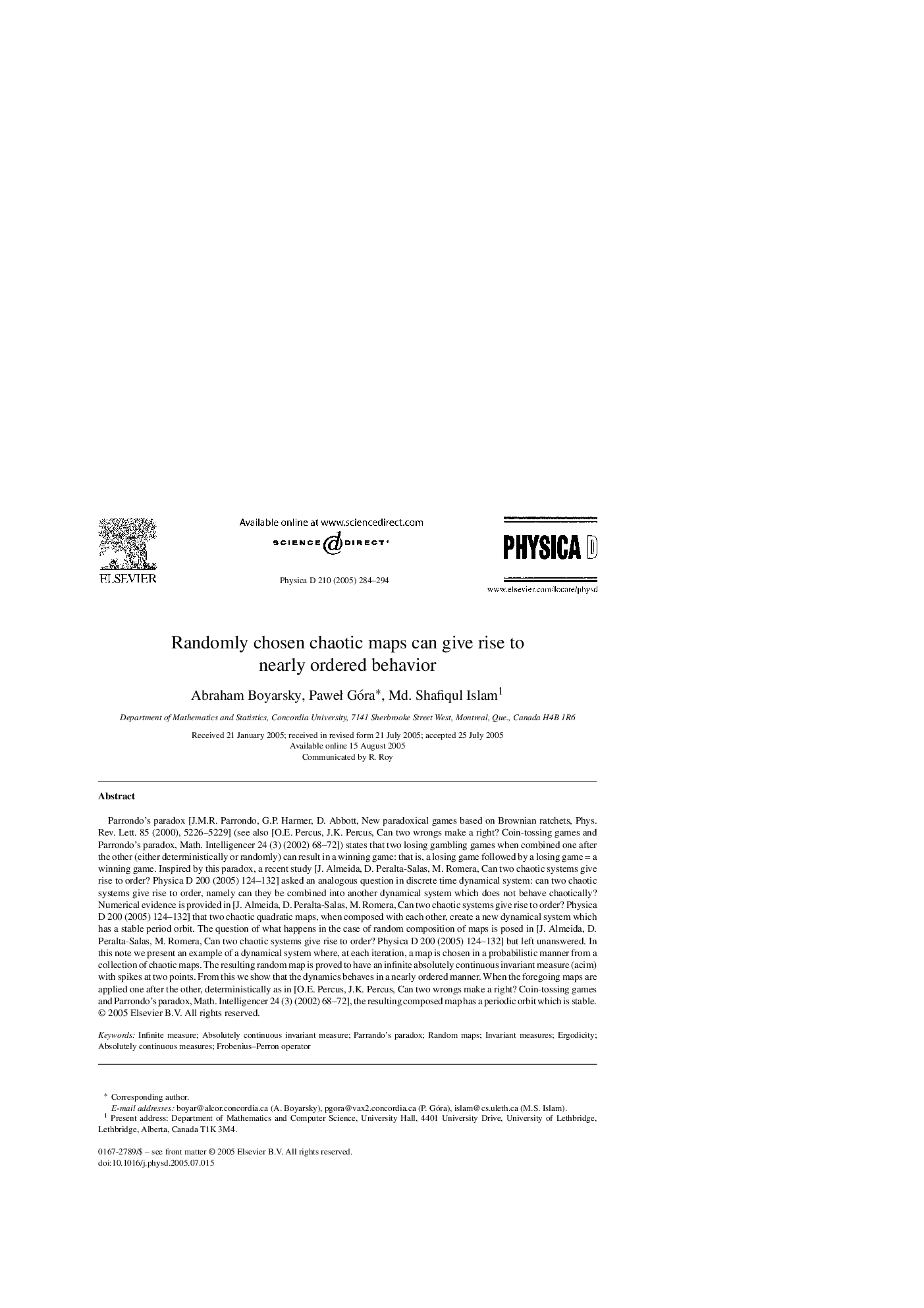| کد مقاله | کد نشریه | سال انتشار | مقاله انگلیسی | نسخه تمام متن |
|---|---|---|---|---|
| 9877537 | 1534079 | 2005 | 11 صفحه PDF | دانلود رایگان |
عنوان انگلیسی مقاله ISI
Randomly chosen chaotic maps can give rise to nearly ordered behavior
دانلود مقاله + سفارش ترجمه
دانلود مقاله ISI انگلیسی
رایگان برای ایرانیان
کلمات کلیدی
موضوعات مرتبط
مهندسی و علوم پایه
ریاضیات
ریاضیات کاربردی
پیش نمایش صفحه اول مقاله

چکیده انگلیسی
Parrondo's paradox [J.M.R. Parrondo, G.P. Harmer, D. Abbott, New paradoxical games based on Brownian ratchets, Phys. Rev. Lett. 85 (2000), 5226-5229] (see also [O.E. Percus, J.K. Percus, Can two wrongs make a right? Coin-tossing games and Parrondo's paradox, Math. Intelligencer 24 (3) (2002) 68-72]) states that two losing gambling games when combined one after the other (either deterministically or randomly) can result in a winning game: that is, a losing game followed by a losing game = a winning game. Inspired by this paradox, a recent study [J. Almeida, D. Peralta-Salas, M. Romera, Can two chaotic systems give rise to order? Physica D 200 (2005) 124-132] asked an analogous question in discrete time dynamical system: can two chaotic systems give rise to order, namely can they be combined into another dynamical system which does not behave chaotically? Numerical evidence is provided in [J. Almeida, D. Peralta-Salas, M. Romera, Can two chaotic systems give rise to order? Physica D 200 (2005) 124-132] that two chaotic quadratic maps, when composed with each other, create a new dynamical system which has a stable period orbit. The question of what happens in the case of random composition of maps is posed in [J. Almeida, D. Peralta-Salas, M. Romera, Can two chaotic systems give rise to order? Physica D 200 (2005) 124-132] but left unanswered. In this note we present an example of a dynamical system where, at each iteration, a map is chosen in a probabilistic manner from a collection of chaotic maps. The resulting random map is proved to have an infinite absolutely continuous invariant measure (acim) with spikes at two points. From this we show that the dynamics behaves in a nearly ordered manner. When the foregoing maps are applied one after the other, deterministically as in [O.E. Percus, J.K. Percus, Can two wrongs make a right? Coin-tossing games and Parrondo's paradox, Math. Intelligencer 24 (3) (2002) 68-72], the resulting composed map has a periodic orbit which is stable.
ناشر
Database: Elsevier - ScienceDirect (ساینس دایرکت)
Journal: Physica D: Nonlinear Phenomena - Volume 210, Issues 3â4, 15 October 2005, Pages 284-294
Journal: Physica D: Nonlinear Phenomena - Volume 210, Issues 3â4, 15 October 2005, Pages 284-294
نویسندگان
Abraham Boyarsky, PaweÅ Góra, Md.Shafiqul Islam,